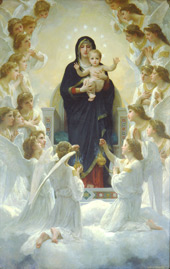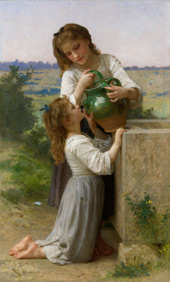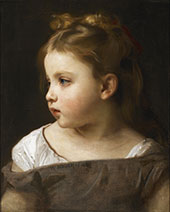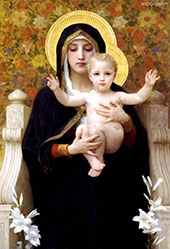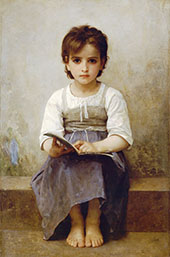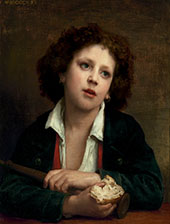William-Adolphe Bouguereau Oil Painting Reproductions
William-Adolphe Bouguereau replica paintings on Canvas for sale
William-Adolphe Bouguereau Paintings: An Artistic Biography
Born on 30 November 1825, William-Adolphe Bouguereau was a leading French academic painter. He was enormously popular during his lifetime, particularly for modern interpretations of classical and mythological themes.
However, as a classic Salon painter, Bouguereau was reviled by new avant-garde movements such as the French Impressionists. As a painter who still engenders strong reactions, we explore William-Adolphe Bouguereau art and his fascinating personal life.
Where is William-Adolphe Bouguereau from?
Bouguereau grew up in France, in La Rochelle (a beautiful seaport on the Bay of Biscay). His family worked as wine and olive oil merchants. Raised as a Catholic, Bouguereau was one of four children.
At seven years old, the family moved to Saint-Martin-de-Ré, a small island off the coast of La Rochelle. Five years later, Bouguereau moved-in with his uncle in Mortagne-sur-Gironde. In a picturesque estuary town, the young boy developed a love of religion, nature, and literature during this time.
He studied for the priesthood in 1839. During his studies, however, Bouguereau learned to draw. Taught by Louis Sage (a pupil of Ingres), it inspired his talent. Returning to his family (now living in Bordeaux), Bouguereau enrolled in the Municipal School of Drawing and Painting in 1841.
The best pupil in his class, he soon decided to move to Paris. Bouguereau produced over 30 oil paintings to fund his travels. At twenty, Bouguereau arrived in Paris as a confident and ambitious young painter.
Enrolling at the École des Beaux-Arts, Bouguereau went to anatomical dissections and studied historical dress and archaeology. He studied under François-Édouard Picot, where Bouguereau gained his later neo-classical style.
What is William-Adolphe Bouguereau known for?
Bouguereau is best known for his stunning neo-classical academic works. Mainly featuring female nudes, he also produced many famous angel paintings. These include beautiful compositions such as Nymphs and Satyr (1873) and The Birth of Venus (1879), and L’Amour et Psyché (1890).
Bouguereau’s quest for classical mastery began early in his career. In 1848, he entered the prestigious Prix de Rome contest. The prize was a three-year residence at the Villa Medici (the French Academy in Rome). Here, young artists could study the Renaissance masters and Greek and Roman antiquities. Sadly, Bouguereau didn’t win.
Undeterred, he entered (again unsuccessfully) the following year. In 1850 however, his final attempt ended with success. Bouguereau entered two paintings, Dante and Virgil and Zenobia, Founded by Shepherds. His Shepherds painting proved successful, and Bouguereau set off for Italy in 1851.
Bouguereau particularly admired Old Master artists such as Leonardo da Vinci, Raphael, Titian, and Michelangelo. Nonetheless, he greatly appreciated more modern painters such as Rubens and Delacroix.
What type of painter was William-Adolphe Bouguereau?
Bouguereau returned to France in 1854. He painted in a highly traditional academic style. Academicism lauded Académie des Beaux-Arts’ standards, particularly prioritizing neo-classical and romantic approaches.
Bouguereau best exemplified the mix of these styles, with classical scenes and narratives portrayed in a distinctly romantic, modern manner. He particularly admired the work of Raphael, following his careful classical approach to form and composition.
From 1854 onwards, he undertook multiple commissions (including decorating a grand pavilion for a cousin in Angoulins). Bouguereau worked incredibly hard, partly to pay off his Italian debts and help his now poverty-stricken mother.
In 1856, Bouguereau moved-in with Nelly Monchablon. Living together outside of marriage was a scandal. Nelly and Bouguereau's first child, Henriette, appeared in 1857. Georges followed in 1859, and Jeanne in 1861.
They married quietly in 1866 as most people assumed they were married. Sadly, their daughter Jeanne died eight days later from tuberculosis. Whilst in mourning, the couple traveled to La Rochelle where Bouguereau created a painting of her.
From 1868 onwards, the family lived in a grand house on the rue Notre-Dame-des-Champs in Paris. with a large top-floor studio for Bouguereau’s work.
After giving birth to two more children (Adolphe and Maurice), Nelly also died of tuberculosis on 3 April 1877.
How many paintings did Bouguereau create?
There are 822 known William-Adolphe Bouguereau paintings. Spread across museum collections around the world.
Bouguereau was awarded the Legion of Honor in 1859. The artist was a firm Salon favorite but around this period he concentrated on more personal compositions.
From the 1860s onwards, Bouguereau taught at the prestigious Académie Julian. Over several decades, he taught thousands of students. While many followed his academic style, others rebelled against it (such as Henri Matisse).
Bouguereau married one of his pupils (the American painter Elizabeth Jane Gardner) after the death of his first wife. However, his mother strongly opposed the marriage, requesting he didn’t marry within her lifetime. Bouguereau wed Gardner in June 1896, after the death of his mother.
Spending most of his life in Paris, Bouguereau also traveled back to La Rochelle regularly. From 1870 onwards, the family spent every summer in the town. They bought a house and farm in 1882, where Bouguereau often finished paintings started in his Paris studio.
Where is Pieta William-Adolphe Bouguereau?
In 1875, Bouguereau commenced work on his most excellent religious painting, Pieta. Today, the painting hangs in the Dallas Museum of Art in Texas, USA.
Completed in 1876, Pieta by William Adolphe Bouguereau appeared at the Paris Salon that year. Created as a tribute to his son George, it is no standard depiction of Mary and Christ. Cradling her dead son, Mary’s darkened, red-rimmed eyes accusingly stare out of the canvas. It’s not a depiction of hope and acceptance but one of anger, blankness, and disbelief.
In Pieta, Bouguereau referenced his own experience of child loss. His son, George, died aged sixteen on 19 July 1875. Sinking into a deep depression for the following six months, Bouguereau resolved to create an oil painting to express his sorrow.
Pieta was thus a work of extreme religious beauty and a touching memorial to the artist’s dead son.
Another famous Bouguereau religious painting is Virgin with Angels (Regina Angelorum). Created in 1900, towards the end of Bouguereau's, the painting demonstrates an artist in complete control of his skills.
Where are Bouguereau paintings?
William-Adolphe Bouguereau’s paintings feature in collections all over the world. Institutions include the Musée d’Orsay in Paris, the Metropolitan Museum of Art in New York, and the J. Paul Getty Museum in Los Angeles.
Throughout his life, Bouguereau stayed a dedicated academicist. He focused on modern interpretations of classical themes, bringing idealized bathers, nymphs, goddesses, and shepherdesses to life.
Bouguereau was also an immensely successful portrait painter. Many of his oil paintings were created for wealthy patrons and remain in private collections. Indeed, one of Bouguereau’s most famous nude paintings, The Wave (or La Vague), remains in private hands.
How did Bouguereau paint?
William-Adolphe Bouguereau art is incredibly meticulous. Painted with careful brushstrokes and attention to detail, he paid particular attention to form and line. Bouguereau also painted prolifically, often creating over twenty individual oil on canvas oil paintings in a single year.
Even in later life, Bouguereau worked six days a week, from dawn to dusk. Indeed, describing his love of painting, Bouguereau told of walking into his studio “full of joy.” When nightfall set, he could barely wait for the following day to begin painting again.
Bouguereau died 19 August 1905. Suffering from heart disease, he passed away in his hometown of La Rochelle. Greatly missed, there was a mass held at the local cathedral. After the second funeral in Paris, Bouguereau’s remains resided at Montparnasse Cemetery in his family vault.
William-Adolphe Bouguereau Art: High quality oil paintings
If you love the classical beauty of William-Adolphe Bouguereau paintings, explore our extensive collection of his art. You’ll find stunning Bouguereau oil paintings to enrich your life and your walls, from famous angel paintings to beautiful portraiture and classical scenes.
Testimonial from Marcus J, Stockholm, Sweden
Cannot Find What You Are Looking For?
Reproduction Gallery Information
Customer Service
(Send Us A Message)
Tel: (503) 937 2010
Fax: (503) 937 2011







